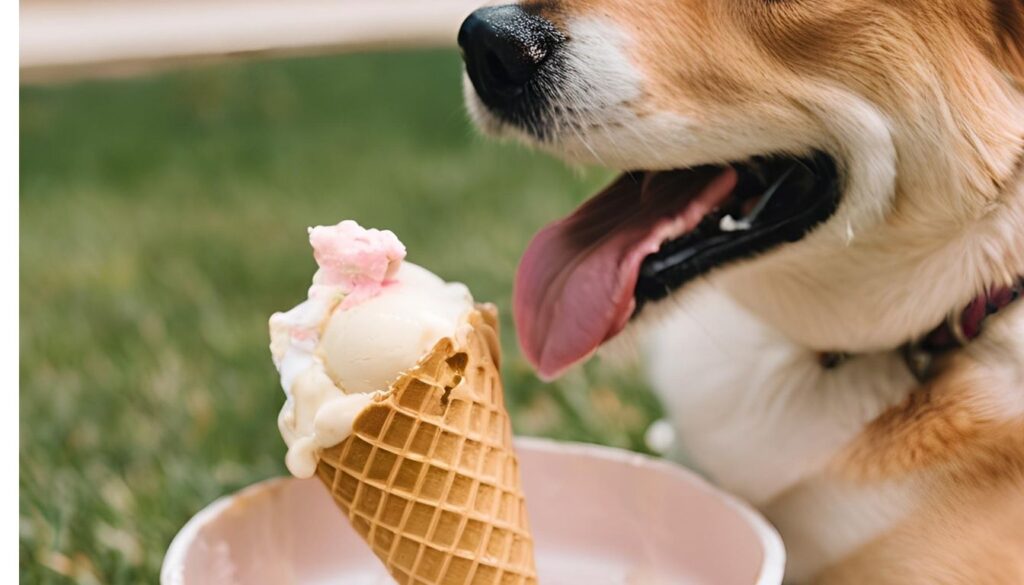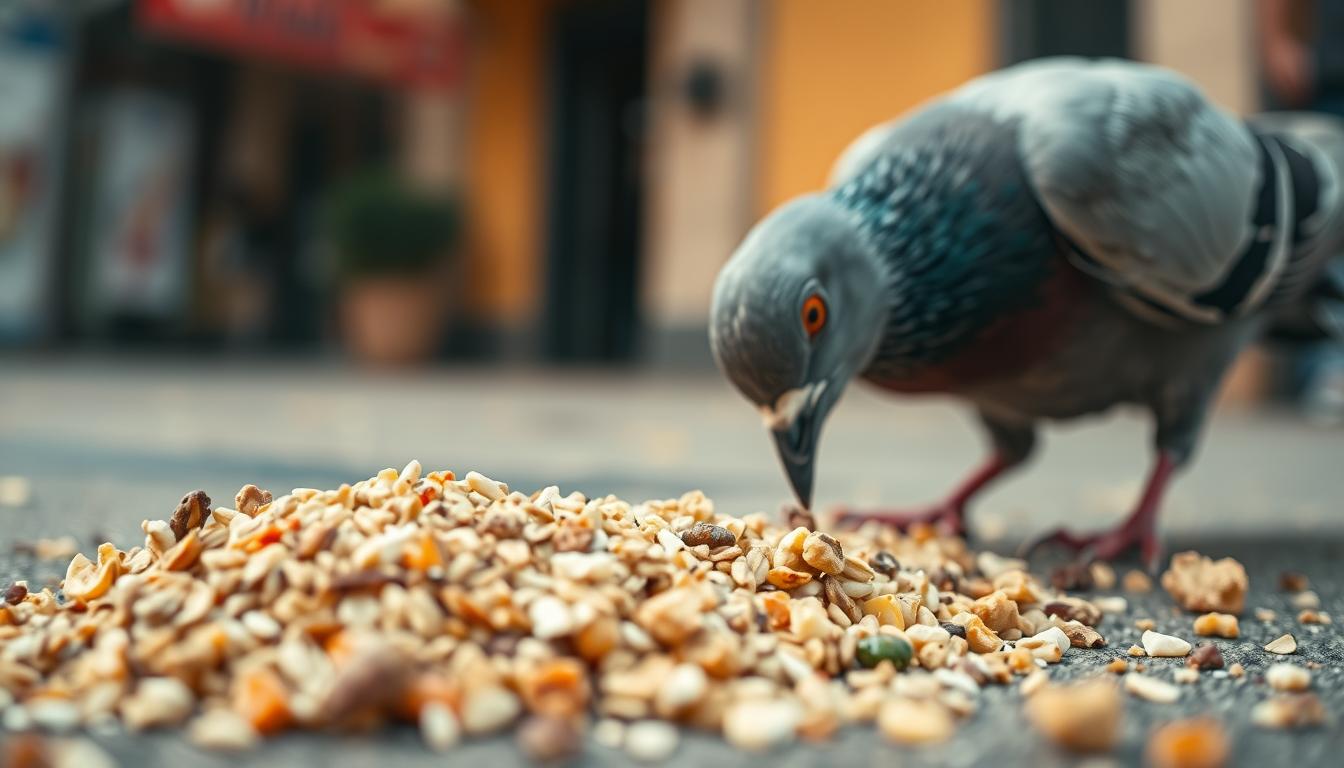Imagine a hot summer day. Your dog looks up at you with those cute puppy eyes. You’re enjoying vanilla ice cream. Before you give it to them, think: is vanilla ice cream safe for dogs? The truth might shock you.
Many pet owners unknowingly risk their dogs’ health by giving them human treats. Even though you mean well, vanilla ice cream can be harmful. It’s important to know the dangers to take good care of your pet.
Dogs need different food than humans. When you ask if dogs can eat vanilla ice cream, vets warn of serious health issues. Toxic ingredients and digestive problems can hurt your furry friend.
Vanilla ice cream’s dangers are more than just a tummy ache. It has too much sugar, alcohol from vanilla extract, and dairy issues. These six reasons will make you think twice before giving it to your dog.
Your dog’s health is the most important thing. Knowing the risks of vanilla ice cream helps you make better choices. This way, you can keep your pet happy and healthy.
Table of Contents
Understanding Vanilla Ice Cream Components and Dog Safety
Is ice cream safe for dogs? It’s important to look at the ingredients in ice cream. Vanilla ice cream can be risky for your dog’s health.
Dogs digest food differently than humans. This makes many ice cream ingredients dangerous for them. Let’s look at the main parts that could harm your dog.
Basic Ingredients in Commercial Vanilla Ice Cream
Vanilla ice cream has ingredients that can harm dogs:
- Heavy cream with high fat content
- Sugar
- Milk proteins
- Vanilla flavoring
Common Additives and Artificial Sweeteners
Commercial ice creams often have additives that are bad for dogs. Xylitol, an artificial sweetener, can cause low blood sugar in dogs.
Dairy Content and Processing Methods
About 50-80% of adult dogs can’t digest dairy well. The way milk and cream are processed can make digestion worse. This can lead to:
- Stomach pain
- Bloating
- Diarrhea
- Gas
Is ice cream safe for dogs? It’s not just a simple yes or no. It depends on your dog’s diet and health risks.
Always talk to your vet before giving your dog human food, like ice cream.
The Hidden Dangers of Vanilla Extract for Canines
Is vanilla ice cream bad for dogs? Pet owners need to know the dangers of vanilla extract. This ingredient can be very harmful to dogs.
Dogs metabolize faster than humans. This means toxins can spread quickly in their bodies. Vanilla extract contains alcohol, which is very dangerous for dogs.
Alcohol Content in Vanilla Extract
Vanilla extract has a lot of alcohol, up to 40%. Even a little can cause serious health problems in dogs.
- Alcohol concentration in vanilla extract ranges from 35-40%
- Even minimal quantities can cause significant toxicity
- Dogs are much more sensitive to alcohol than humans
Toxic Effects on Dogs’ Systems
When dogs eat vanilla extract, they quickly absorb the alcohol. This can lead to serious health issues. The toxins can affect many parts of their body.
- Central nervous system depression
- Potential liver damage
- Respiratory complications
- Metabolic disruptions
Signs of Vanilla Extract Poisoning
It’s important to know the signs of vanilla extract poisoning. Look out for these symptoms if your dog has eaten vanilla extract:
- Disorientation and confusion
- Vomiting or diarrhea
- Seizures or tremors
- Breathing difficulties
- Excessive hyperactivity
- Signs of dehydration
Remember, is vanilla ice cream bad for dogs? The answer is a resounding yes, because of the risks from vanilla extract.
Is Vanilla Ice Cream Bad for Dogs: Understanding the Risks
Thinking about whether dogs can have vanilla ice cream? Pet owners need to know about serious health risks. Even a small lick might not be safe. Is ice cream okay for dogs? The answer is not a simple yes or no.
Dogs can face many health problems from vanilla ice cream:
- Lactose intolerance affects about 70-80% of adult dogs
- High sugar can cause quick weight gain
- Fat can lead to pancreatitis
- Allergic reactions are possible
Digestive issues are common. Symptoms like diarrhea, vomiting, and stomach pain can show up fast after eating dairy. The mix of dairy, sugar, and fat makes vanilla ice cream risky for dogs.
Veterinary experts say to avoid dairy desserts for dogs, even more so for those with health issues.
Pet owners should watch for bad reactions. If your dog eats vanilla ice cream by mistake, watch for signs of trouble. If you’re unsure, call your vet for advice.
Lactose Intolerance and Digestive Issues in Dogs
It’s important for dog owners to understand lactose intolerance in dogs. Most adult dogs have trouble digesting dairy, which can lead to health problems. Every dog parent should know about these issues.

About 10% of dogs have lactose intolerance. This can cause uncomfortable and serious digestive problems. The main reason is a lack of lactase enzyme, which breaks down milk sugars.
Common Symptoms of Dairy Sensitivity
Dogs eating dairy, like ice cream, can face various digestive issues:
- Bloating and excessive gas
- Diarrhea
- Stomach cramps
- Vomiting
- Reduced appetite
Breed-Specific Lactose Concerns
Some dog breeds are more likely to have lactose intolerance. Smaller breeds and certain genetic lines have more sensitive stomachs. They can’t handle dairy as well.
Age-Related Dairy Tolerance
Puppies have more lactase enzymes than older dogs. As they grow, their ability to digest milk decreases. Older dogs find it harder to digest milk than younger ones.
Veterinarians suggest introducing new foods slowly and watching your dog’s reaction.
When choosing treats for your dog, remember dairy should be less than 10% of their diet. Always put your dog’s digestive health first. Talk to a vet about the best food choices for them.
Sugar Content and Its Impact on Canine Health
Is vanilla ice cream bad for dogs? Yes, it is because of the sugar. Dogs have fewer taste buds than humans but can still get sick from sugar.
Eating foods with lots of sugar, like vanilla ice cream, can harm dogs. The dangers include:
- Rapid weight gain
- Increased diabetes risk
- Dental health problems
- Metabolic disorders
Vets say dogs should only have a little sugar. They should get no more than 10% of their diet from sugar. The rest should be healthy dog food.
Too much sugar can cause big problems. Eating treats like vanilla ice cream often can lead to:
- Obesity
- Pancreatitis
- Chronic digestive issues
- Potential insulin resistance
Even a small taste of sugar can be risky. It’s better to give dogs treats made just for them. These treats help keep them healthy.
The Truth About Fat Content in Ice Cream
When thinking about can dogs eat vanilla ice cream, knowing the fat content is key. Vanilla ice cream has a lot of fat. This can be very bad for your dog’s health.
Ice cream’s fat can cause big health problems for dogs. The high calories and saturated fats can lead to serious issues.
Impact on Pancreatic Health
Too much fat can make dogs very sick. It can cause pancreatitis, a painful condition. This happens when the pancreas gets inflamed.
This can lead to:
- Severe abdominal pain
- Persistent vomiting
- Loss of appetite
- Potential organ damage
Weight Management Concerns
High-fat treats like vanilla ice cream can make dogs gain weight. Being overweight is bad for dogs. It can lead to:
- Increased diabetes risk
- Joint stress
- Reduced mobility
- Decreased life expectancy
Long-term Health Effects
Regularly giving dogs vanilla ice cream can cause long-term health problems. Veterinary experts say to avoid high-fat dairy treats. This helps keep your dog healthy and prevents metabolic issues.
Safe Alternatives to Vanilla Ice Cream for Dogs
Keeping your furry friend cool and happy doesn’t mean risking their health with traditional ice cream. There are delicious and safe options that will make your dog’s tail wag with excitement.
Let’s explore some fantastic pet ice cream alternatives that are both nutritious and refreshing:
- Frozen Fruit Treats: Blueberries, strawberries, and bananas make excellent frozen snacks packed with nutrients
- Plain unsweetened yogurt popsicles for a protein-rich cool treat
- Homemade puree-based frozen treats using pumpkin or sweet potato
- Commercial dog-friendly frozen desserts designed for canine nutrition
When creating pet ice cream alternatives, focus on ingredients that are safe and beneficial. The market for dog-friendly frozen treats is growing. Many options now prioritize your pet’s health.
“The best treats are those that make your dog happy and healthy!” – Veterinary Nutrition Experts
Remember that moderation is key. Even with pet ice cream alternatives, small portions are recommended. This prevents digestive issues or weight gain. Always consult with your veterinarian about the best treat options for your specific dog’s dietary needs.
- Check ingredient labels carefully
- Avoid artificial sweeteners
- Choose low-sugar options
- Watch for any allergic reactions
Your dog deserves delicious, safe cooling treats that support their overall health and happiness!
Emergency Response: What to Do If Your Dog Eats Too Much Ice Cream

Discovering your dog has eaten a lot of ice cream can be scary. While ice cream is not always safe for dogs, knowing what to do can help. It’s important to act quickly to protect your pet’s health.
If your dog has eaten a lot of vanilla ice cream, here’s what to do:
- Watch your dog closely for any strange symptoms
- Look for signs of stomach upset
- Remember how much and what kind of ice cream they ate
Look out for these signs that mean you should call your vet:
- Persistent vomiting
- Diarrhea that lasts more than a day
- Feeling very tired
- Stomach pain that doesn’t go away
“When in doubt, always consult a professional. Your veterinarian can provide the most accurate guidance for your dog’s specific situation.”
About 10% of dogs can’t digest lactose well, which means ice cream can be risky. If your dog has bad symptoms or you’re worried, call your vet right away. Or, you can reach the Pet Poison Helpline at (855)764-7661.
Preventing problems is always better than fixing them. Think about giving your dog safe, healthy treats instead of ice cream in the future.
Conclusion
Your dog’s health is very important. Knowing the dangers of vanilla ice cream is key. Is vanilla ice cream bad for dogs? Yes, it is.
Dairy can cause big problems like diarrhea, vomiting, and stomach pain. Many adult dogs can’t digest lactose well. This leads to these uncomfortable symptoms.
But there’s more to worry about. Vanilla ice cream’s sugar and fat can harm your dog’s health over time. It can lead to obesity, dental issues, metabolic problems, and diabetes.
Artificial sweeteners like xylitol are even more dangerous. They can cause serious harm in dogs.
Instead of risking your pet’s health, try safer options. Homemade treats with fat-free Greek yogurt, ripe bananas, or dog-safe ice cream are better. They let your dog enjoy something sweet without harming their health.
Being a responsible pet owner means making smart food choices. While treats are tempting, your dog’s health should always come first. Talk to your vet to create a diet that’s good for your dog’s health and happiness.
FAQ
Is vanilla ice cream toxic to dogs?
Vanilla ice cream isn’t toxic right away, but it can harm dogs. It has alcohol in vanilla extract, which is bad for dogs. The sugar and fat can also cause weight gain, stomach problems, and pancreatitis.
Can dogs have even a small amount of vanilla ice cream?
It’s best to keep dogs away from vanilla ice cream. Dogs can’t digest lactose well, and the treat has sugar, dairy, and additives that can upset their stomachs.
What are the specific risks of dogs eating vanilla ice cream?
Dogs face risks like lactose intolerance and obesity from sugar. The alcohol in vanilla extract can be toxic. They might also get digestive issues and pancreatitis from the fat.
Are there any safe ice cream alternatives for dogs?
Yes! You can make safe treats for dogs with plain yogurt, pureed fruits, or pet-safe ice creams. These options are cool and safe, unlike regular ice cream.
How can I tell if my dog is lactose intolerant?
Dogs with lactose intolerance might show signs like bloating, gas, diarrhea, vomiting, and stomach pain after eating dairy. Some dogs might react worse than others.
What should I do if my dog accidentally eats vanilla ice cream?
Watch for signs like vomiting, diarrhea, or feeling tired. If they eat a lot, call your vet right away. Even small amounts can cause mild problems, so it’s good to get advice.
Can puppies tolerate vanilla ice cream better than adult dogs?
No, puppies are more sensitive to dairy and sugar. Their stomachs are more delicate, making them more likely to get sick from vanilla ice cream than adult dogs.
Are there any artificial sweeteners in vanilla ice cream that are dangerous to dogs?
Yes, Xylitol is very bad for dogs. It can cause their blood sugar to drop too low and even liver failure. Always check labels and avoid treats with artificial sweeteners.
Source Links
- Can Dogs Eat Vanilla? Vet-Approved Facts & FAQs | Hepper – https://www.hepper.com/can-dogs-eat-vanilla/
- What Human Foods Can Dogs Eat? 35 Foods Fido Can Eat Too – https://www.rd.com/list/human-foods-good-for-dog/
- Can Dogs Eat Ice Cream? The Full Scoop on Why You Should Avoid It! | fourpawpals.com – https://fourpawpals.com/can-dogs-eat-ice-cream/
- Frequently Asked Questions – Straus Family Creamery – https://www.strausfamilycreamery.com/faqs/
- What Not to Share: People Foods That Can Harm Your Dog – https://woofcrate.ca/blogs/woofpost-blog/what-not-to-share-people-foods-that-can-harm-your-dog?srsltid=AfmBOopYChb6HgTLcLeZQ7J5yD1eI52Ia8T9aZmhE59SboAOf6wLehHe
- We Tasted Four Dog Ice Creams. Here’s Our Favorite Scoop – https://figopetinsurance.com/blog/dog-friendly-ice-cream
- Xylitol Poisoning in Dogs – https://www.petmd.com/dog/poisoning/xylitol-poisoning-in-dogs
- No title found – https://www.akc.org/expert-advice/nutrition/can-dogs-eat-ice-cream/
- Can Dogs Eat Ice Cream? Is it Safe for Your Pooch? – https://thevets.com/blog/can-dogs-eat-ice-cream/
- Can Dogs Drink Milk? | Dog Food Advisor – https://www.dogfoodadvisor.com/canine-nutrition/dogs-milk-dairy-products/
- Can Dogs Eat Ice Cream? Here’s What the Experts Say – https://www.rd.com/article/can-dogs-eat-ice-cream/
- Can Dogs Eat Sugar? – https://www.petmd.com/dog/nutrition/can-dogs-eat-sugar
- Can Dogs Eat Ice Cream? What Every Pet Owner Should Know – https://www.pumpkin.care/blog/can-dogs-eat-ice-cream/
- Can Dogs Eat Ice Cream? – https://www.thesprucepets.com/can-dogs-eat-ice-cream-4684033
- Can Dogs Eat Ice Cream? Vet-Verified Health & Safety Guide – Dogster – https://www.dogster.com/dog-nutrition/can-dogs-eat-ice-cream
- Is Ice Cream for Dogs Safe? What You Need to Know About This Popular Treat – Petful – https://www.petful.com/pet-health/ice-cream-for-dogs/
- Can Dogs Eat Ice Cream? The Pros and Cons | Spot® – https://spotpet.com/blog/dog-tips/can-dogs-eat-ice-cream
- Can dogs eat ice cream? – https://www.naturesmenu.co.uk/blog-can-dogs-eat-ice-cream.html
- No title found – https://www.akc.org/expert-advice/nutrition/human-foods-dogs-can-and-cant-eat/
- Can Dogs Eat Mint Ice Cream? Vet-Verified Risks & FAQ | PangoVet – https://pangovet.com/pet-nutrition/dogs/can-dogs-eat-mint-ice-cream/
- Can Dogs Have Ice Cream? – https://basepaws.com/dog-insider/can-dogs-eat-ice-cream
- Can Dogs Have Vanilla? Vet-Verified Nutrition Facts & FAQ – Dogster – https://www.dogster.com/dog-nutrition/can-dogs-have-vanilla




